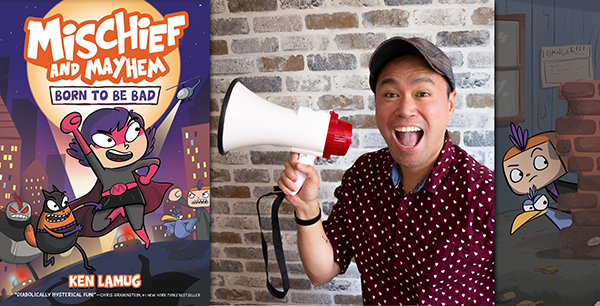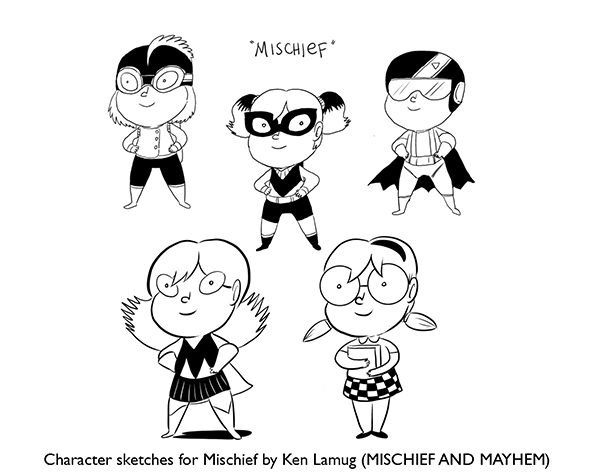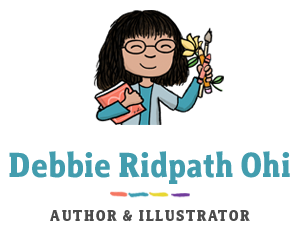
Author-illustrator Ken Lamug has created award-winning picture books and graphic novels. Born in the Philippines, Ken moved to the US with his entire family during his teenage years. His debut middle grade graphic series, MISCHIEF AND MAYHEM #1: BORN TO BE BAD, launched this week from Katherine Tegen Books / HarperCollins!
Mischief and Mayhem is about Missy and her cat Gizmo. They were kicked out of superhero bootcamp. Now it’s time for some super-villainy! I love the plot twist that the main character, Missy, decides she doesn’t really fit into the labels the world she lives in has created; she’s not really a villain, nor is she a superhero.
Links where you can find out more: MischiefBook.com, Ken on Twitter, Facebook and Instagram. His website: Rabbleboy.com.
Q. I read that MISCHIEF AND MAYHEM started as a 32-page picture book story. How did it end up as a graphic novel?
Yep! The idea for Mischief and Mayhem started as a 32-page picture book – originally titled “Mischief the Supervillain”. At the time, I was focused on my picture book ideas and wasn’t even considering graphic novels. I had experience illustrating books, so I knew it was just a matter of time until something clicked for me. I went through the steps book creators are familiar with: writing the manuscript, creating dummies, and many rounds of revisions.
The dummy went through the submission process and even hopped to another agent (when I switched to a new one). We received a few rejections and a few interesting comments. One of the more resounding comments was that the idea was cool and needed to be expanded. But the picture book format limited what we could do.
We finally received an acceptance offer along with a caveat… turn it into a graphic novel! Yikes!
A few things scared me about this: it would have to be in full color, and at least 240+ pages. How does one turn a 32-page picture book into something that big?
And before anything was signed, I had to give the editorial team a few things: a fully illustrated first chapter, and a full outline for the book. This would give them a better idea of the story and my comic style. So I added new characters, expanded the moments from the story, and added a lot of jokes!
Once the editorial team gave the thumbs up, I was off to the races to get my debut graphic novel complete.

EXTRA: You can find out more about Ken’s process as well as sample sketches in his Q&A with We Need Diverse Books.
Q. I’ve been thinking about a graphic novel middle grade project, but am intimidated by the amount of time the ART could take. Do you have any tips? How much time did MISCHIEF AND MAYHEM TAKE YOU in total? Were you working on anything else at the same time?
No kidding. Graphic novels ARE a lot of work. I’ve easily spent 1000 hours on Mischief and Mayhem (including creating marketing materials, videos, etc.). I also have a day job, so most of my after-hours are spent working on the book (typically around 5 hours on the weekdays). I basically stare at the computer screen all day!
During this time, I was also creating art for a picture book. And since the schedule for picture books are a bit more relaxed, I was able to squeeze it in without much problem.
Here are some tips I hope you’ll find useful:
1. Working digitally has helped increase my productivity. It’s easier to create dummies, inking, make revisions, and get feedback.
2. Scheduling and planning are very important. Find out the deadline, how many pages you can complete per day, and do the math.
In my case, I’ve determined that I am inking(outlining) about 1 page per hour. This means it will take me roughly 250 hours to outline a 250-page book. Based on that number, I can then determine if my deadline is a realistic goal. I know, it’s a lot of math but it does help and you will be able to strategize how you approach the project.
3. Streamlining your art style. This varies depending on your abilities and time. Some artists are blessed enough to work full-time on their books and with longer deadlines. But if you’re not one of them, then I would suggest streamlining the look of your characters, your drawing techniques so you can work faster and efficiently. Some artists are able to also hire a team to help support the rest of the task such as coloring, inking, letter, etc., but a majority of graphic creators are one-person operations.
4. Don’t forget to take a break and enjoy life.

Q. What advice do you have for young graphic novel writers and illustrators?
Start small. You don’t have to create a big “novel” length book right away. I started my comic book journey when I submitted a 4-page comic to an anthology. After I gained some confidence, I started creating 24-page comic one-shots (single issues). And it just kept growing from there.
Comics should be fun for both the creator and the reader, so make sure to enjoy the process and don’t stress out about getting it right the first time.
Q. What’s next for you?
I just finished illustrating a picture book called FAMILY BUSINESS (by Lenore Appelhans). It’s about a raccoon family who seems to always get into trouble. I’m excited for that to come out (no dates yet).
I’m also in the middle of Mischief and Mayhem book 2. As I write this my hand is hurting from illustrating a “Where’s Waldo-Esque” spread. Ha! But I’m proud to say the art has improved and the story is even bigger than the first one.
I’ve never really had a big plan for my drawing/art career. It’s all a blessing and a humbling experience. I just hope that the readers love the stories and connect with the characters. So we’ll see what happens next!
For more insights from book creators, see my Inkygirl Interview Archives and Advice For Young Writers And Illustrators From Book Creators.

